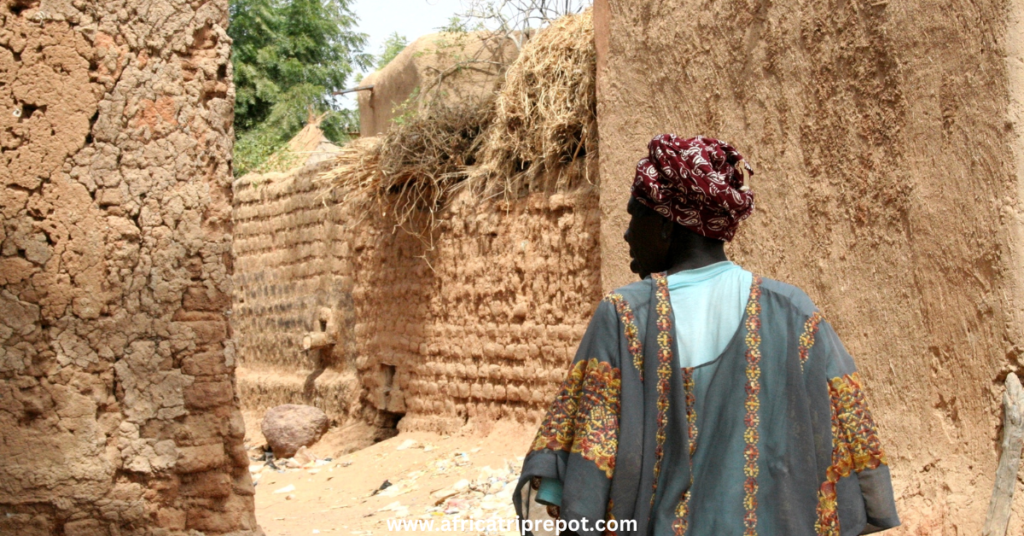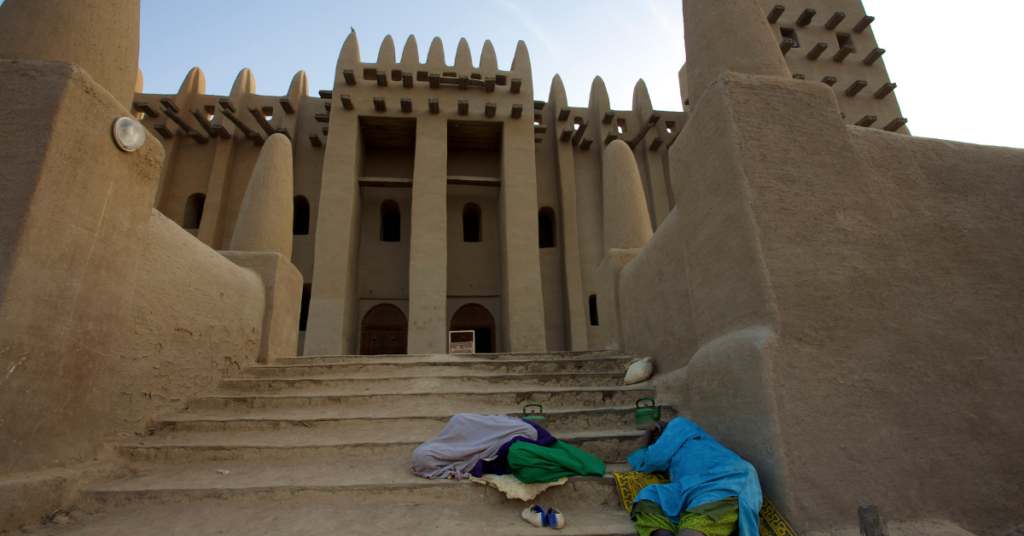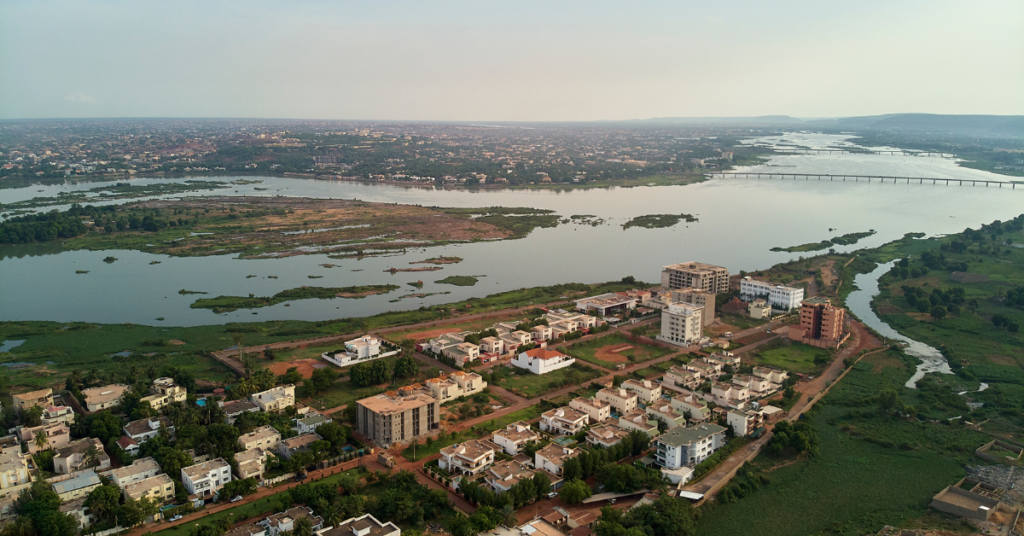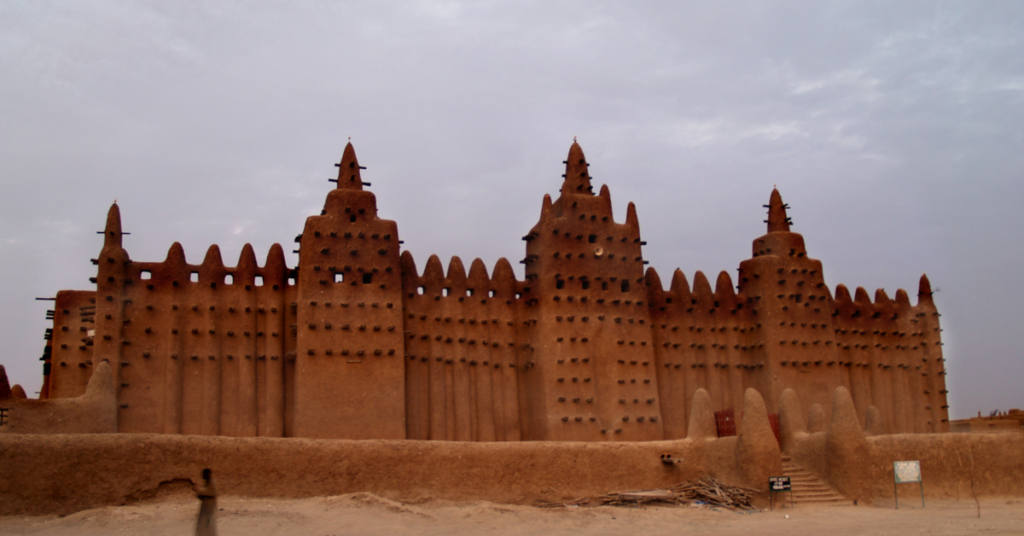Are challenges your thing? Prepare to discover Mali’s amazing sites by packing your bags! Everyone can savor this West African nation’s spectacular natural beauty and rich historical landmarks. We’ll list the top 10 Mali’s Most Spectacular Attractions that you absolutely must see in this post and take you on a tour that will leave you astonished. So if you’re looking for a new and fascinating vacation spot or are interested in history, nature, or both, get ready to be astounded by Mali’s stunning beauty and rich culture. Let’s dive in and explore everything that this gorgeous nation has to offer!
1. Djenné’s Great Mosque

Djenné’s Great Mosque is not only a stunning architectural masterpiece but also a fascinating piece of history that is a must-see for anyone visiting Mali. As one of the largest mud-brick structures in the world, this mosque is a true engineering marvel that has stood the test of time for centuries.
How To Get There: Right now, with the current security situation, the only recommended way to get to Djenne is through a reputable travel agency and in your own private car. Also, you should only do a 2-day trip maximum.
Do I Need To Pay Anything?: Remember that there is a small entrance fee and that you must wear modest clothing and take off your shoes before entering the mosque if you wish to do so. You’ll be captivated by the serene ambiance and the sense of antiquity that permeates the area as soon as you step inside.
Current Security Situation: While Mali has faced some security challenges in recent years, Djenné remains a safe and welcoming destination for tourists (but it´s still recommended to travel with a reputable travel agency). However, it’s always a good idea to check the current security situation before traveling and to follow any recommended safety guidelines.
2. Timbuktu’s Old Town

Timbuktu, the fabled desert city, is a place that has captivated the imaginations of travelers and explorers for centuries. It’s easy to see why – with its sandy streets, towering mud-brick buildings, and rich cultural heritage, Timbuktu is a destination like no other.
Once you arrive in Timbuktu, you’ll be struck by the city’s unique atmosphere. There are no cars here, only donkeys and carts navigating the narrow streets. You can explore the city’s many historic mosques, libraries, and traditional homes, which have been beautifully preserved over the centuries.
How To Get There: It is difficult to reach Timbuktu; you either fly privately or take a boat up the Niger River. But getting there is half the fun, and you’ll feel like you’re going back in time as you traverse the Saharan terrain.
Recommendations: Also keep in mind that you must dress modestly and remove your shoes before entering mosques or other religious locations, as well as that there is a small entrance fee for Timbuktu’s historical monuments.
Current Security Situation:
Current Security Situation: While Timbuktu has faced some security challenges in recent years, it’s still possible to visit this incredible city as long as you take the necessary precautions. It’s always a good idea to check the current security situation before traveling, and to follow any recommended safety guidelines.
3. Dogon Country

A truly must-see for anybody interested in history, culture, and spectacular natural beauty, Dogon Country is one of Mali’s most fascinating tourist sites. The Dogon people, who have lived in Dogon Country in the center of Mali for generations and have managed to maintain their ancient way of life and rituals, call this region home.
What Is Dogon Famous For: One of the main highlights of Dogon Country is hiking through the many small villages scattered throughout the area, each offering its own unique charm and beauty. With villages perched high up on the plateau or nestled in the sandy lowlands, you’ll be treated to stunning vistas and an unforgettable experience.
The hike may require some effort, but the reward is worth it. You’ll get a chance to witness the daily lives and traditions of the local Dogon people, learn about their customs, and be welcomed into their community. So why wait? Take the plunge and explore the enchanting Dogon Country on foot – it’s an adventure you won’t forget!
How To Get In: While it may seem daunting, the experience is well worth the effort. With a driver, you can expect to pay around 50,000 CFA per day plus gas, but don’t be afraid to negotiate for a better price – especially if you plan on renting for multiple days or traveling during the low season. Be prepared to stand your ground, as some drivers can be difficult and may not be eager to make multiple stops in a day.
Current Security Situation: You cannot even think about visiting Dogon right now.
4. Mopti’s Grand Mosque

Mopti, the bustling port town of Mali, is the ultimate gateway to some of the most impressive attractions the country has to offer. It’s not just a stopover destination, but an adventure in itself. From the historical and cultural wonders of Djenné and Timbuktu to the breathtaking natural beauty of Dogon Country, Mopti serves as a perfect starting point for your Mali expedition. So why wait? Get ready to embark on an unforgettable journey of discovery from Mopti!
How To Get There: Traveling to Mopti is easy and convenient with regular bus services running between the nearby city of Sevare and the capital city Bamako. Sevare being on the main road, it is often easier to reach there first and then catch a local bus to Mopti. There´s another option. You can also opt for a boat ride to Mopti when the rivers are high. Boats from both Timbuktu and Djenné offer scenic and unforgettable journeys to Mopti, allowing you to soak in the stunning natural beauty of the region while also experiencing the traditional means of transportation that have been used for centuries.
What Can I Do In Mopti? Embark on a thrilling journey aboard a pinasse, the traditional boat of Mali, and explore the nearby Bozo villages like never before. The best part? It won’t cost you a fortune! You can enjoy a two-hour pinasse ride for just 5,000 CFA, giving you ample time to soak in the scenic beauty and cultural wonders of the region.
But be wary of the notorious pinasse mafia at the harbor, who may try to control the pricing and ask for exorbitant amounts (up to 30,000 CFA for just one hour!). Don’t fall for their tricks and avoid them at all costs. Instead, opt for an authentic and affordable pinasse ride to explore the rich traditions and lifestyles of the Bozo villages in Mali. Get ready to experience the real Mali, up close and personal.
Current Security Situation: Mopti is right now off limits. But we´ve heard of some adventurers that have ventured to visit the city.
5. Bamako

The vibrant capital of Mali, Bamako, is a busy metropolis with a distinct personality that provides travelers with a real African experience. The city is a must-visit location for everyone visiting West Africa since it successfully combines modernism with traditional African culture.
The National Museum of Mali, the Bamako Grand Mosque, and bustling markets like the Marche Medina, which provide an insight into the vibrant local culture, are just a few of the many sites that can be explored after visitors arrive in Bamako.
How Expensive Is Bamako: Bamako is not the best place for travelers on a tight budget because of how pricey staying there is. Taxis and buses are the most often used forms of local transportation, and both are relatively affordable. However, hiring a private vehicle is also recommended, even if the cost can be quite high.
Current Security Situation: Despite the ongoing security concerns in Mali, Bamako has remained a relatively safe destination for travelers. However, it’s always a good idea to keep up to date with the current situation and travel advisories before planning a trip.
6. Ségou

Segou is a quaint village in the center of Mali that is well-known for its extensive history, cultural significance, and picturesque surroundings. Segou is the ideal place to go if you want to see Mali for what it really is.
You’ll be welcomed by Segou’s lively markets, busy streets, and hospitable residents once you get there. You can explore the town’s small lanes and come across brightly painted structures, traditional mud homes, and loud music.
One of Segou’s main attractions is its vibrant art scene. The town is home to many talented artisans, and you can visit their workshops to see them creating beautiful pottery, textiles, and other handicrafts. There are also several art festivals held in Segou throughout the year, including the popular Festival sur le Niger.
For history enthusiasts, Segou has a rich past as the former capital of the Bambara Empire. You can visit the ruins of the old palace, explore the ancient mosques and tombs, and learn about the town’s fascinating history at the Segou Regional Museum.
How To Get There: From Bamako, the capital of the country of Mali, you may take a bus to Segou for about 3,000 CFA. The views of the Malian countryside are stunning during the four-hour journey. You might also hire a private car or cab to get around more conveniently and pleasantly.
Current Security Situation: Segou is one of the most secure places in Mali right now.
7. La Dune Rose

Any visitor to Mali must explore the breathtaking natural beauty known as La Dune Rose. This magnificent sand dune, which is close to Timbuktu, is a breathtaking and extraordinary sight to behold.
The dune has a stunning rose color, as the name would imply, and it is especially stunning at sunrise and dusk. The ascent to the summit of the dune is strenuous but rewarding, providing a magnificent panorama of the surrounding desert landscape.
How To Get There: Either a cab or a rental automobile can take you from Timbuktu to La Dune Rose. A nominal entrance charge must be paid to enter the region, and the trip takes around 30 minutes. The dune is situated in the desert, so remember to pack plenty of water and sunscreen.
Current Security Situation: Not a good idea to visit this place right now.
8. The Niger River

The Niger River, sometimes referred to as “The River of Life,” is one of West Africa’s most important waterways. It covers a distance of more than 4,200 kilometers and traverses five nations, including Mali. You won’t want to miss an expedition down the Niger River if you’re searching for a distinctive experience in Mali.
Expert Tip: Taking a boat excursion is one of the greatest ways to experience the river. The price varies depending on the length of the trip and the type of boat you select, and there are several alternatives available, ranging from individual charters to group tours. Some tours even give participants the chance to spend the night in a traditional Niger River boat, which may be an unforgettable experience when done beneath the stars.
9. Tomb of Askia in Gao

The Tomb of Askia in Gao is a truly impressive historical monument that showcases the rich cultural heritage of Mali. Located in the ancient city of Gao, this tomb is a testament to the power and influence of the Askia dynasty, which ruled the region in the 15th and 16th centuries.
A superb example of West African architecture is the tomb itself, which has lofty walls and ornate decorations. The many rooms and passageways inside of this remarkable edifice are open to visitors’ exploration.
Current Security Situation: This place is COMPLETELY OFF LIMITS!!!
10. The Gouro Sculptures in San
The Gouro Sculptures in San are a true hidden gem of Mali that are not to be missed. Located in the small town of San, these stunning sculptures are a testament to the incredible artistry and creativity of the Gouro people.
Even by themselves, the statues are quite lovely. They portray a diverse range of animals, people, and legendary creatures and are carved from a variety of materials, including wood and stone. Each sculpture is distinctive and tells a story about the Gouro people’s rich cultural heritage.
How To Get There: Our recommendation would be to only do it in your own private car, and with someone knowledgeable of the area.
Current Security Situation: It’s wise to research the current security situation before visiting San, like with all travel in Mali. While the town and its surroundings are generally secure for visitors, it’s crucial to take any necessary safety measures to guarantee a fun and secure journey.
Expert Tip: Hire a local guide who can explain the significance and history of these amazing sculptures. A guide can provide a deeper knowledge of the cultural context in which the sculptures were produced in addition to assisting you in navigating the region and locating the most intriguing sculptures. Supporting regional tour operators and companies also helps to boost the local economy and maintain the preservation of these priceless cultural assets.

I’m a total Africa enthusiast! I’ve been exploring this amazing continent for years and I can’t get enough of its diverse cultures, stunning landscapes, and incredible wildlife. From hiking through the savannahs to sampling local cuisine, I’m all about immersing myself in everything Africa has to offer. I’m constantly on the lookout for new and exciting experiences, and I love sharing my passion and knowledge with fellow travel lovers. If you’re looking for an adventure like no other, Africa is the place to be, and I’m here to help you make the most of it!





